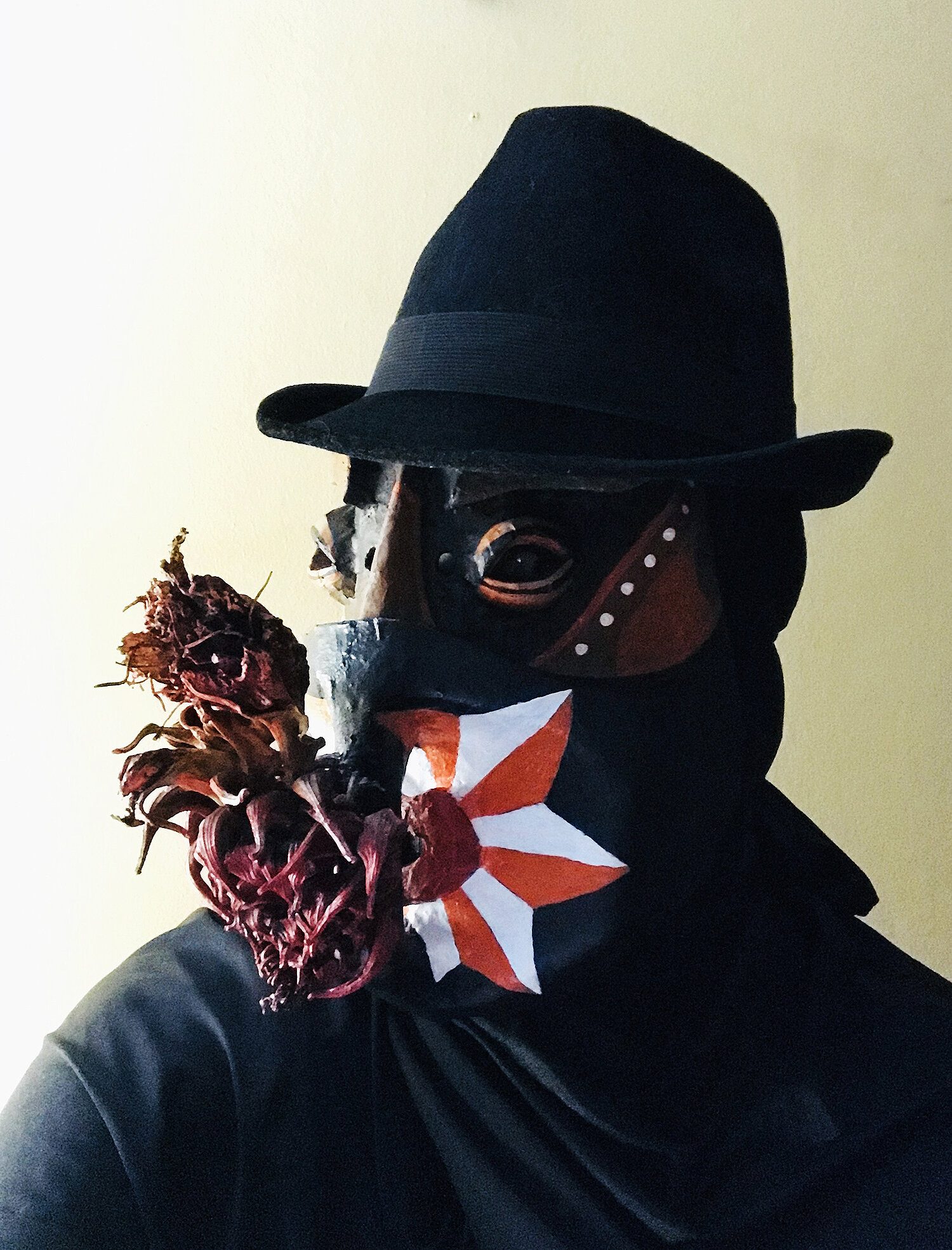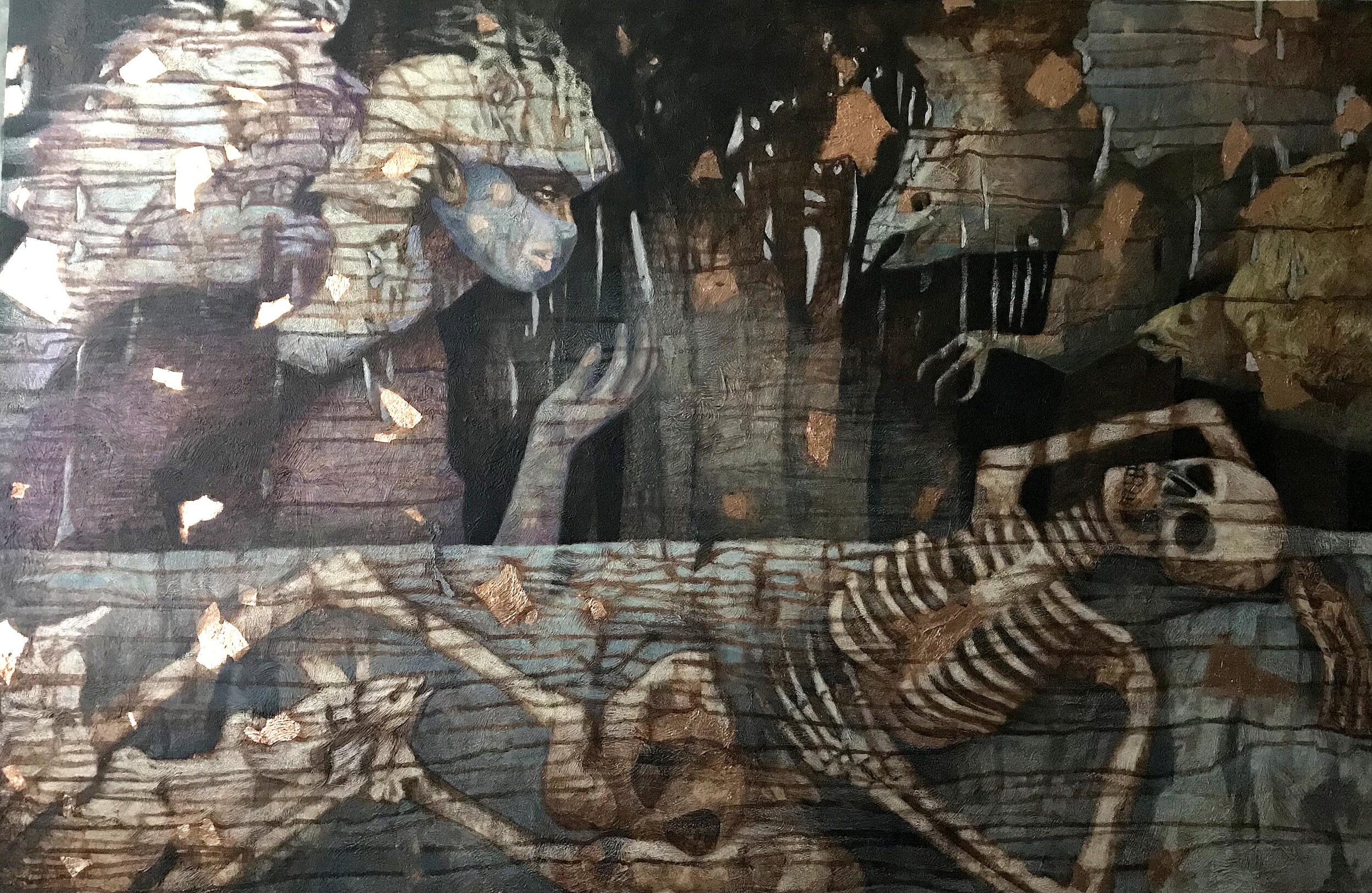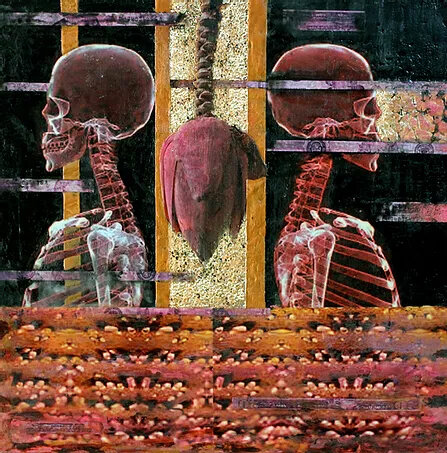marlene Hernández casillas
Protective Mask for the Archaic Human
of the current future (2020)
Acrylic, papier-mâché, recycled plastic, African Tulip Tree flower. 11Wx7.5Lx8D (inches)
For purchase inquiries please contact the artist at
mhcasillas08@gmail.com
For more about this artist, visit
https://marlenehernandez.wixsite.com/marlene-h
Selected Exhibitions
Salon International Val D’Orz, Paris
Salon International Des Arts XV, Paris
Rockefeller Center, New York
Museo de Las Américas, San Juan
Art Dubai, UAE
Galería Edward De Valle, Art Basel Miami
Fyn Gallery, Florence, Italy
Jadite Gallery, New York
Museo y Centro de Estudios Humanisticos,
Universidad del Turabo, Puerto Rico
In the Heart of the Pandemic, by Marlene Hernández Casillas. Acrylic on canvas, 30x40 inches. 2020. All Rights Reserved.
La Mensajera conversa con la muerte by Marlene Hernández Casillas. 2020. Acrylic on canvas with Prismacolor. 60 x 40 inches.
The Fortune Teller, by Marlene Hernández Casillas. 2020.
All Rights Reserved.
Paredes de Oro, by Marlene Hernández Casillas. Encaustic.
All Rights Reserved.
Agnus, by Marlene Hernández Casillas. Encaustic. All Rights Reserved.
Vendido, by Marlene Hernández Casillas. Encaustic. All Rights Reserved.
The Mocking Alien, by Marlene Hernández Casillas. 2020.
All Rights Reserved.
The Lady and the Mirror, by Marlene Hernández Casillas. All Rights Reserved.
Artist’s statement
The human being faces his own truth in this century. To be aware of each breath is to relearn, to re-examine in his own fragility, how powerless we are before the forces of nature. Human life is short, and the planet has perpetually and harmoniously self-regulated, from time immemorial,
without us.
In our archaic and tribal concepts, we believe we have evolved, trusting in our limited knowledge of science and in our ability to overcome everything. Still we are helpless in the face of our own ability to breathe with nature and understand the mysteries of life and death.
Nature constantly offers strong incentive for us to act as part of it, but we insist on the self-centeredness, blindness and ambition that leads us wildly to self-destruction.
This century has begun with a new opportunity to regain respect for Mother Earth and to learn to breathe with her.
About the Artist
Born in San Juan, Puerto Rico in 1969, Ms. Hernández Casillas studied at the Andrés Bueso Art Academy in San Juan and the School of Fine Arts in San Juan. She studied further with Alfonso Arana and Francoise Bricaut in Paris, France 1989-90. She received her BFA in 1991 and was a delegate at the EXPO 1992 World’s Fair in Sevilla, Spain. In 2013 she earned her Master in Arts at Centro de Estudios Avanzados de Puerto Rico y el Caribe in San Juan.
Public Collections
Museo de Arte de Caguas, Puerto Rico
Alfonso Arana Collection
The Latino Art Museum of California
Awards
Institute of Puerto Rican Culture, Grant
Museum of the Americas, Doral, FL, Mention of Honor
Feature
Ms. Hernández Casillas was our featured artist for March 17-23, 2021. We feature an artist of the Babel Masks Ad-Hoc Collective each week.
10 questions
Your mask, Protective Mask for the Archaic Human of the
Current Future, links us with the idea that we are still archaic, but we entertain delusions of supremacy thanks to our knowledge of science and technology; that we are out of step with nature. Can you say more about the way this mask functions in the environment 100 years from now? Is it to protect us from the environment, or vice-versa?
The mask I have created for this exhibition functions as a metaphor. The Now, from a philosophical perspective, is the present moment in which we are alive and present, aware of and compassionate towards our environment. The Now, a continuity without date, is the eternal present.
The Covid-19 pandemic has reawakened us to our human fragility in the face of life and death. This mask represents a recognition of that nature in and around us. It is also an acknowledgment that despite our conceit, we as a species have not evolved or grown enough. In a way, we are still primitive beings. No matter how far we advance the boundaries of science and technology, the natural order of things always overwhelms us, humbling our human pride.
Whenever our species faces a pandemic, our only option is to find a way to survive, and consequently to search in nature for new medicine. Eventually, we will have to realize that the damage we do to nature is also damage we do to ourselves.
What is the story of this character who is wearing the mask? Where are they living, and how have they chosen the adornments on this mask? Can you say more about this?
While working on this mask, I meditated on the ideas mentioned above and imagined myself in a timeless Somewhere, a place where the virus continues to haunt us, but now, at last, a place where we recognize the pollution in ourselves.
The body demands contact with the earth -- its colors, its flora and fauna -- in order to feel alive. It also needs silence. It needs a world without genders, a place where conscious people protect what remains.
Prior to this full-face tribal mask, I designed a half-mask for the self-portrait In the Heart of the Pandemic (Acrylic on canvas, 30 "x 40". 2021). The original photograph that inspired the painting is titled Sacred Heart of Covid. The flower has a mysterious and eerie quality. On the one hand, the flower invokes divinity in its resemblance to the flaming heart that represents Jesus. On the other hand, the flower’s forms are as strange as the shape of this virus that has reached us and shown us new paths.
On your website, you show a series of encaustics that seem to
prefigure this mask – the conjunction of the animal and the vegetal, the anatomy interlaced with pods and robust blooms, such as in Vendido and Agnus. There also seems to be a connection between the sculpture of our own skeletons and the fossilized remains of prehistoric creatures. Can you tell us a little more about this series?
It is related in a way. I have even taken up the human skeleton in my recent work, for example in La Mensajera conversa con la muerte (The Messenger Talks With Death) (Acrylic on canvas and prismacolor. 60 "x 40" 2020) This painting refers to the present pandemic’s severity. It serves as an allegory or a character who is human prayer personified, who visits death and leaves all disease there. The idea of the skeleton as fossil is interesting, something petrified by time, but I view it more from the living angle, with skin and muscle covering the bones. In a way, we are a kind of walking fossil: we are buried alive in the body, experiencing things from there.
The encaustics were part of a series entitled Organic Matter (2010-11). These works connect the three ideas of being: being as object/product, being as emotional entity, and being as a consumerist mass-production machine. These three ways of being and not-being comprise an organism where the strongest aspect survives. It considers the modality or concept of “organic” as a synonym for “healthy” to mask the underlying exploitation and consumer market struggles which are the market’s true organizing principles.
In your statement you write, “Nature constantly offers strong
incentive for us to act as part of it, but we insist on the self-centeredness, blindness and ambition that leads us wildly to self-‐destruction.” In the archaic future of this mask, has the human species grown in archaic wisdom, or do you foresee that we will still be fighting against the natural systems of the earth?
In that world of the "archaic" future, behind whatever mask can be at that time, I would love to know that human beings have finally evolved to a greater emotional intelligence, a balanced, serene and fair brain, and a heart that can comprehend one’s natural environment. Without being pessimistic, I still feel many lessons and injuries await us. I am concerned about the trust we place in technology to oversimplify approaches or take short-cuts to a solution. Such "advances" are double-edged blades, capable of harm as well as solutions. Machines do not sleep. They regulate themselves. They commodify our information to benefit the consumer market and they read our lives through social networks to support that market. Machines numb us, destabilize our societies, and separate us from nature and from ourselves. Meanwhile, we are sapped of energy: we age without necessarily evolving.
In your statement you also say, “The human being faces his own truth in this century. To be aware of each breath is to re-learn, to re-examine in his own fragility, how powerless we are before the forces of nature.” Can you say more about this?
The saying goes well: "No one learns from someone else's head.” We learn from our own mistakes.
We have seen through time of what transcendental changes consist, especially when we refer to humanity and its behavior. Though we as citizens of the 21st century can plainly see the harmful effects of climate change, we are at the mercy of a corporatocracy whose policies are not interested in protecting the environment. There is a system to be transcended here if we are interested in our own survival and evolution.
Likewise, we have an opportunity to transcend our outdated (even obsolete) educational system. To evolve our approach toward education in the American hemisphere, a more comprehensive set of learning paths must start in childhood: a learning path to cultivate peaceful and productive coexistence with all countries and cultures, and a path to promote a sense of stewardship over the environment: this has already been understood by Japan and other countries. We must realize a more comprehensive idea of what it means to be educated: not everyone can be scientific, technological, or mathematical; the humanities must be included. We must incorporate multiple ways of learning to reflect the reality that not everyone learns by the same approach. We must be concerned with the lifelong well-being of our students. It is imperative that we cultivate in them a humanist perspective, a sense of vocation, and an appreciation for diversity. The planet is already sending clear and forceful signals of our peril in a changing climate. We must direct successive generations to respect nature and strive to make real progress in our relationship to it. It is essential to include in our descendants’ education a respect for nature and the fundamental understanding that nature always follows its course and responds strongly to forces not acting in harmony with it. This is a time of deep observation and immediate action.
Can you talk about mentors or other artists or teachers who had a strong influence on your work? How do you feel you have influenced other artists who see and examine your work?
The first ones who come to mind are my painting and engraving teachers, Andrés and Andy Bueso, who showed me the path of art and taught me the academic tools necessary for a well-founded creativity. Among them also
are Fran Cervonni, José R. Alicea, Consuelo Gotay. In sculpture, Adelino González. In performance, Awilda Sterling, Freddie Mercado, and Pedro Adorno, among other great Puerto Rican artists. I have also been fortunate to learn with great masters in other countries. I studied engraving with Francoise Bricaut in Paris, and I studied performance and mask-making with Deborah Hunt, a New Zealand artist who fortunately lives in Puerto Rico. These marvelous artists’ influences are present in my work and a part of my continuous evolution.
Have I influenced other artists and colleagues? I hope I have. One simply continues to work and share what the soul impels. Certainly, at some point, when one works from the heart and with enthusiasm, some of that is perpetuated in other people.
Can you talk a little bit about what media and subjects have your attention now? What are you working on that you can talk about, or what projects are ahead of you?
At the moment, I am working on painting and papier‐mâché mask-making. I am also writing short stories and making videos. All media act as a catharsis on the subjects already expressed here. There are so many things to say and do. I am also interested in continuing studies related to psychology with a focus on the arts as a healing tool.
How often does collaboration come into the methods of your artistic
practice?
I like to collaborate in community projects by giving art workshops, especially in support of institutions that address the concerns of battered women and children with special needs. There is much that we artists can offer to help maintain emotional balance in sectors that need it urgently, and art is a key tool in the field of psychology to help and rediscover the path towards self-healing.
How would you express your mission as an artist in a few sentences? What do you hope your work will bring to the world?
My mission as an artist is to promote change, to educate, to provoke curiosity and to cultivate a desire to investigate. I have been in the plastic arts profession since I was very young. Fortunately, I have been able to work for 26 years now as an exhibit coordinator and designer at the Museum of the Americas in Puerto Rico. Many have been the experiences and things learned from other artists and colleagues. Today at 52 years of age, I still envision myself in the arts until my last breath, to create awareness and help others to live.
If you were speaking to an artist just beginning the path, what would you advise them? What do you wish you had known when you were just starting out?
I would recommend to the new aspiring artist to investigate all the possibilities that exist today as creative careers. There are so many options. Consider the fact that every article of daily use must first be designed. Every object emerges from an idea that an artist has realized, captured, and manifested. Art is a practical necessity in our world: to be creative is imperative.
To become an artist, you should be aware of what is happening, the needs that surround us. The artist is an ally in the effort to maintain balance in the social order. Art reflects how we live and what is possible. To be an artist is to be an agent of change. To do that, the artist must study history, philosophy, and the humanities. The artist attests, in his work, to what is happening in the world and in the collective psyche.









